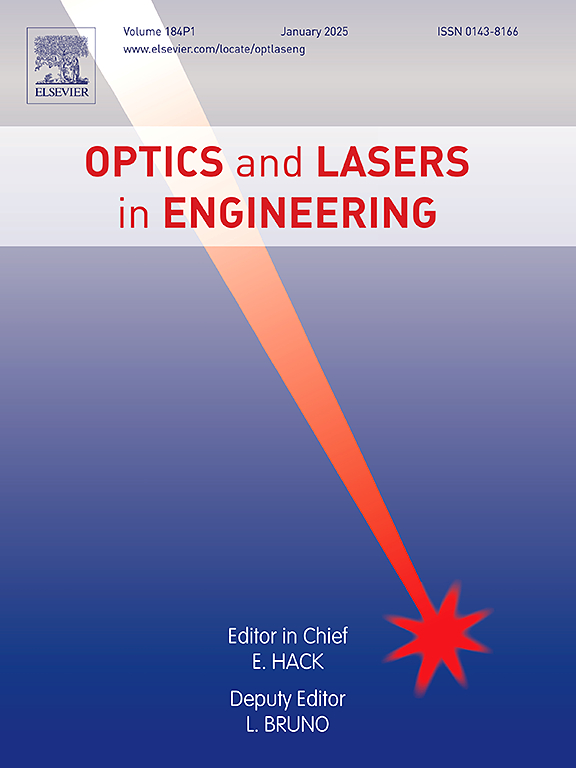水下激光后向探测通道在气泡诱导湍流中的预测机制
IF 3.5
2区 工程技术
Q2 OPTICS
引用次数: 0
摘要
气泡湍流对水下激光反向探测通道的稳定性、探测信息的准确性和探测系统的分辨率提出了巨大的挑战。水下无线光通信中激光前向传输信道的研究大多采用现有的方法。然而,由于两者的接收方式不同,再加上水下后向散射信道的复杂性和可变性,前向传输信道法并不适合表征激光后向探测信道的变化。基于水下气泡场的时空分布规律和激光后向散射理论,提出了异步混合气泡层诱导湍流下激光后向探测通道的加权预测机制。利用这一机制,对气泡诱导湍流条件下后向激光探测通道的强度波动分布特性进行了统计和实验研究。引入光斑闪烁系数来量化气泡密度和尺度对激光后向散射强度的影响。基于相关系数(R2)和均方根误差进行拟合优度检验,验证模型的准确性,量化混合气泡诱导湍流对激光后向探测通道的影响。结果表明:该模型在50 ~ 1000 μm气泡尺寸和100 ~ 2000 cm−3气泡密度下的拟合度为95%,且气泡尺寸诱导湍流的变化对通道强度波动的影响大于气泡密度诱导湍流的变化。这些结果为水下激光雷达探测提供了潜在的理论应用。本文章由计算机程序翻译,如有差异,请以英文原文为准。
Predictive mechanisms for underwater laser backward detection channel in bubble-induced turbulence
Bubble-induced turbulence poses tremendous challenges to the stability of underwater laser backward detection channels, accuracy of detection information, and resolution of detection systems. Majority of the existing methods are adopted from the research on laser forward transmission channels in underwater wireless optical communication. However, owing to the different reception modes of the two, coupled with the complexity and variability of the underwater backward scattering channel, the forward transmission channel method is not suitable for characterizing the change of laser backward detection channel.. Based on the spatiotemporal distribution law of the underwater bubble field and laser backscattering theory, a weighted predictive mechanism for the laser backward detection channel under the induced turbulence of an asynchronous mixed bubble layer is proposed. Using this mechanism, the distribution characteristics of the intensity fluctuation of a backward laser detection channel under bubble-induced turbulence were studied statistically and experimentally. The spot scintillation coefficient (SI) was introduced to quantify the effects of the bubble density and scale on the laser backscatter intensity. A goodness-of-fit test was performed based on the correlation coefficient (R2) and root mean square error to verify the accuracy of the model, and the effect of mixed bubble-induced turbulence on the laser backward detection channel was quantified. The results show that the model has 95 % fitting degree at 50–1000 μm bubble size and 100–2000 cm−3 bubble density, and the change in bubble size-induced turbulence has a greater effect on channel intensity fluctuation compared to the change in bubble density-induced turbulence. These results provide a potential theoretical application of underwater LiDAR detection.
求助全文
通过发布文献求助,成功后即可免费获取论文全文。
去求助
来源期刊

Optics and Lasers in Engineering
工程技术-光学
CiteScore
8.90
自引率
8.70%
发文量
384
审稿时长
42 days
期刊介绍:
Optics and Lasers in Engineering aims at providing an international forum for the interchange of information on the development of optical techniques and laser technology in engineering. Emphasis is placed on contributions targeted at the practical use of methods and devices, the development and enhancement of solutions and new theoretical concepts for experimental methods.
Optics and Lasers in Engineering reflects the main areas in which optical methods are being used and developed for an engineering environment. Manuscripts should offer clear evidence of novelty and significance. Papers focusing on parameter optimization or computational issues are not suitable. Similarly, papers focussed on an application rather than the optical method fall outside the journal''s scope. The scope of the journal is defined to include the following:
-Optical Metrology-
Optical Methods for 3D visualization and virtual engineering-
Optical Techniques for Microsystems-
Imaging, Microscopy and Adaptive Optics-
Computational Imaging-
Laser methods in manufacturing-
Integrated optical and photonic sensors-
Optics and Photonics in Life Science-
Hyperspectral and spectroscopic methods-
Infrared and Terahertz techniques
 求助内容:
求助内容: 应助结果提醒方式:
应助结果提醒方式:


